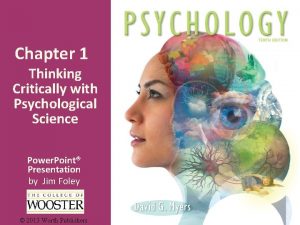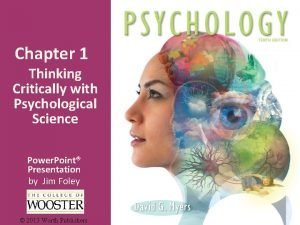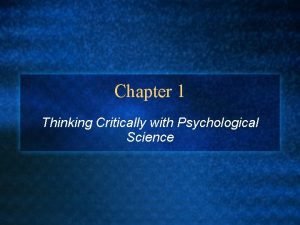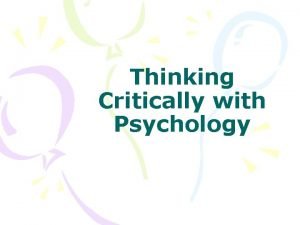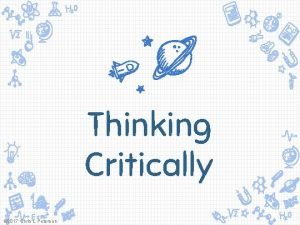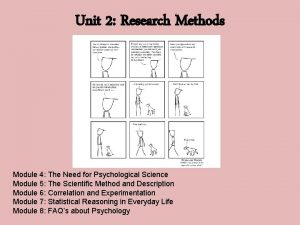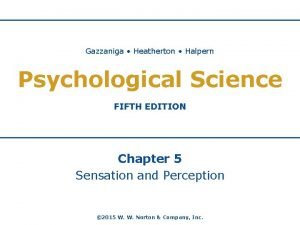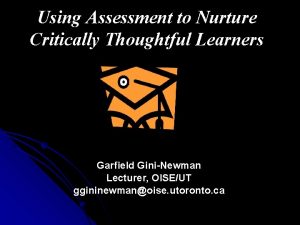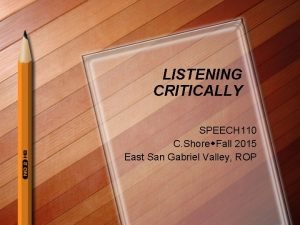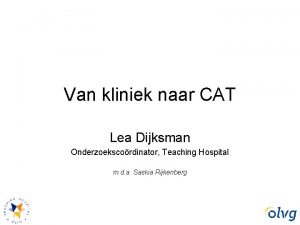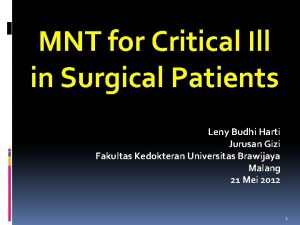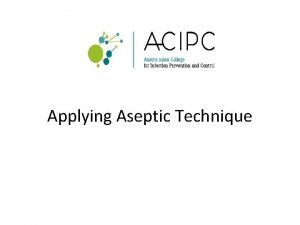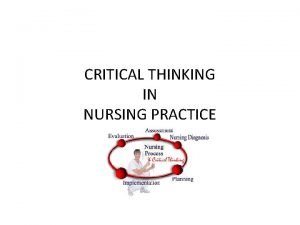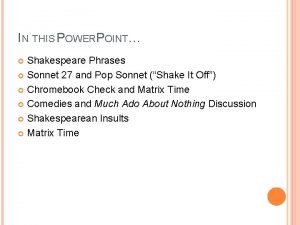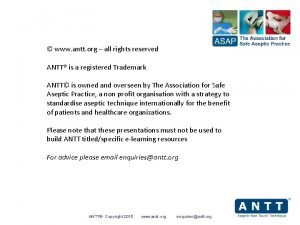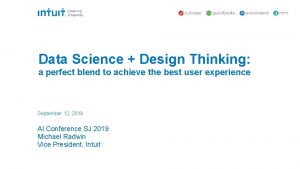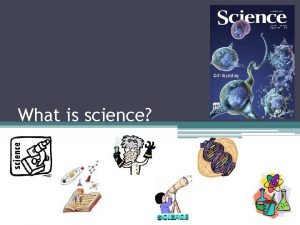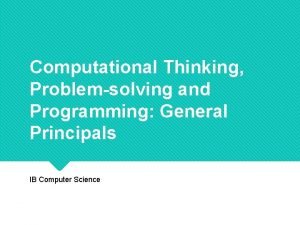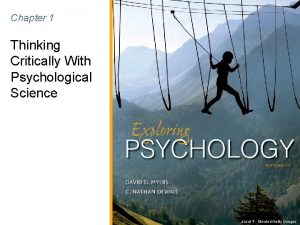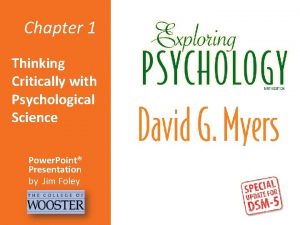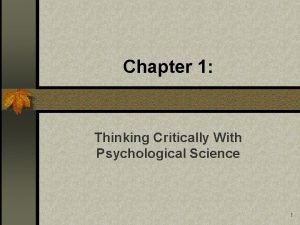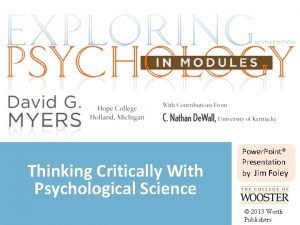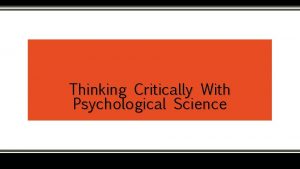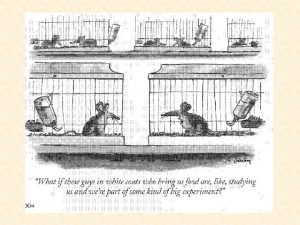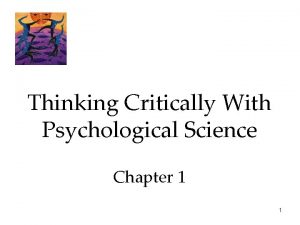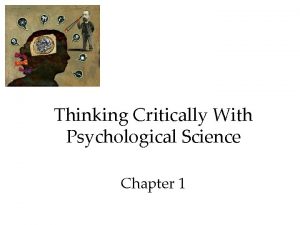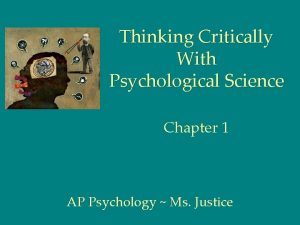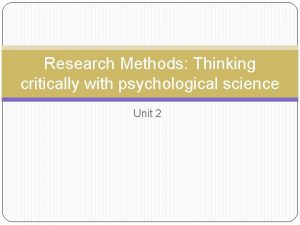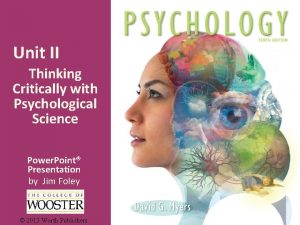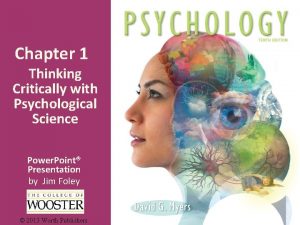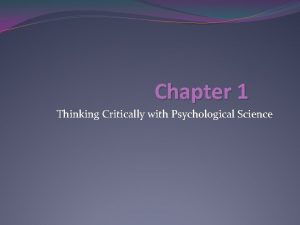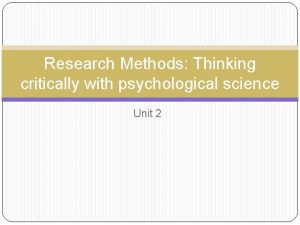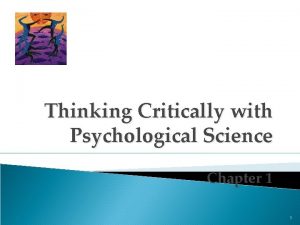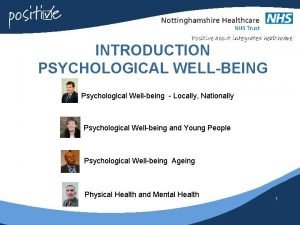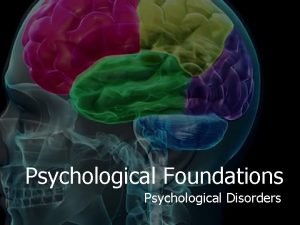THINKING CRITICALLY WITH PSYCHOLOGICAL SCIENCE 1 THINKING CRITICALLY


































- Slides: 34

THINKING CRITICALLY WITH PSYCHOLOGICAL SCIENCE 1

THINKING CRITICALLY WITH PSYCHOLOGICAL SCIENCE The Need for Psychological Science § The limits of Intuition and Common Sense § The Scientific Attitude § The Scientific Method 2

IMPRESSION OF PSYCHOLOGY With hopes of satisfying curiosity, many people listen to talk-radio counselors and psychics to learn about others and themselves. Psychic (Ball gazing) http: //www. photovault. com http: //www. nbc. com Dr. Crane (radio-shrink) 3

THE NEED FOR PSYCHOLOGICAL SCIENCE Intuition & Common Sense Many people believe that intuition and common sense are enough to bring forth answers regarding human nature. Intuition and common sense may aid queries, but they are not free of error. 4

PSYCHOLOGICAL SCIENCE 1. 2. How can we differentiate between uniformed opinions and examined conclusions? The science of psychology helps make these examined conclusions, which leads to our understanding of how people feel, think, and act as they do! 5

CRITICAL THINKING It examines assumptions, discerns hidden values, evaluates evidence and assesses conclusions. Courtesy of the James Randi Education Foundation Critical thinking does not accept arguments and conclusions blindly. 6

SCIENTIFIC METHOD Psychologists, like all scientists, use the scientific method to construct theories that organize, summarize and simplify observations. 7

THEORY A Theory is an explanation that integrates principles and organizes and predicts behavior or events. For example, low self-esteem contributes to depression. 8

HYPOTHESIS A Hypothesis is a testable prediction, often prompted by a theory, to enable us to accept, reject or revise theory. People with low selfesteem are apt to feel more depressed. 9

RESEARCH OBSERVATIONS Research would require us to administer tests of self-esteem and depression. Individuals who score low on a self-esteem test and high on a depression test would confirm our hypothesis. 10

DESCRIPTION Case Study A technique in which one person is studied in depth to reveal underlying behavioral principles. Susan Kuklin/ Photo Researchers Is language uniquely human? 11

CASE STUDY Clinical Study http: //behavioralhealth. typepad. com A clinical study is a form of case study in which therapist investigates the problems associated with a client. 12

SURVEY A technique for ascertaining the self-reported attitudes, opinions or behaviors of people usually done by questioning a representative, random sample of people. http: //www. lynnefeatherstone. org 13

SURVEY Wording Effect Wording can change the results of a survey. Q: Should cigarette ads and pornography be allowed on television? 14

SURVEY Random Sampling If each member of a population has an equal chance of inclusion into a sample, it is called a random sample (unbiased). If the survey sample is biased, its results are not valid. The fastest way to know about the marble color ratio is to blindly transfer a few into a smaller jar and count them. 15

NATURALISTIC OBSERVATION Observing and recording the behavior of animals in the wild and recording self-seating patterns in a multiracial school lunch room constitute naturalistic observation. Courtesy of Gilda Morelli 16

DESCRIPTIVE METHODS Summary Case studies, surveys, and naturalistic observation describe behaviors. 17

CORRELATION When one trait or behavior accompanies another, we say the two correlate. Indicates strength of relationship (0. 00 to 1. 00) Correlation coefficient Correlation Coefficient is a statistical measure of the relationship between two variables. r = + 0. 37 Indicates direction of relationship (positive or negative) 18

CORRELATION AND CAUSATION or 19

CORRELATION AND CAUSATION 20

EXPERIMENTATION Exploring Cause and Effect Like other sciences, experimentation is the backbone of psychology research. Experiments isolate causes and their effects. 21

EXPLORING CAUSE & EFFECT Many factors influence our behavior. Experiments (1) manipulate factors that interest us, while other factors are kept under (2) control. Effects generated by manipulated factors isolate cause and effect relationships. 22

DEPENDENT VARIABLE A Dependent Variable is a factor that may change in response to an independent variable. In psychology, it is usually a behavior or a mental process. For example, in our study on the effect of breast feeding upon intelligence, intelligence is the dependent variable. 23

INDEPENDENT VARIABLE An Independent Variable is a factor manipulated by the experimenter. The effect of the independent variable is the focus of the study. For example, when examining the effects of breast feeding upon intelligence, breast feeding is the independent variable. 24

EXPERIMENT RESEARCH METHOD Experimental group – the group that the independent variable is applied. Control group the group that the independent variable IS NOT applied to. 25

EVALUATING THERAPIES Random Assignment Assigning participants to experimental (Breastfed) and control (formula-fed) conditions by random assignment minimizes pre-existing differences between the two groups. 26

PROBLEMS AND SOLUTIONS IN RESEARCH Self-fulfilling prophecy – where expectations effect behavior unknowingly.

PROBLEMS AND SOLUTIONS IN RESEARCH The Placebo Effect The belief in the cure that changes behavior.

PROBLEMS AND SOLUTIONS IN RESEARCH Single-blind experiment study in which participants are unaware of which get treatment. Double-blind experiment study in which both experimenters and participants are unaware of which participants receive treatment

EXPERIMENTATION A summary of steps during experimentation. 30

DESCRIBING DATA A meaningful description of data is important in research. Misrepresentation may lead to incorrect conclusions. 31

MEASURES OF CENTRAL TENDENCY Mode: The most frequently occurring score in a distribution. Mean: The arithmetic average of scores in a distribution obtained by adding the scores and then dividing by the number of scores that were added together. Median: The middle score in a rank-ordered distribution. 32


ETHICAL ISSUES Protecting Participants: confidentiality, signing wavers, dignity and welfare Obeying Laws Minimizing factors that lead to misleading results. Providing results.
 Thinking critically with psychological science
Thinking critically with psychological science Thinking critically with psychological science
Thinking critically with psychological science Thinking critically with psychological science answer key
Thinking critically with psychological science answer key Thinking critically
Thinking critically Thinking critically
Thinking critically Geography is my favourite at school
Geography is my favourite at school Module 4 the need for psychological science
Module 4 the need for psychological science Rotating snake illusion
Rotating snake illusion Thoughtful learning
Thoughtful learning Listening critically
Listening critically Pico cat voorbeeld
Pico cat voorbeeld Care of critically ill surgical patient
Care of critically ill surgical patient Surgical metabolism
Surgical metabolism What is aseptic
What is aseptic Importance of critical thinking in nursing process
Importance of critical thinking in nursing process Shakespeare sonnet 27 translation
Shakespeare sonnet 27 translation Negative issues
Negative issues Valid safeguards in antt
Valid safeguards in antt Positive thinking vs negative thinking examples
Positive thinking vs negative thinking examples Thinking about your own thinking
Thinking about your own thinking Holistic thinking example
Holistic thinking example Perbedaan critical thinking dan creative thinking
Perbedaan critical thinking dan creative thinking Thinking about you thinking about me
Thinking about you thinking about me Overdraft
Overdraft Science is a process of thinking
Science is a process of thinking Thinking procedurally computer science
Thinking procedurally computer science Social science vs natural science
Social science vs natural science Six branches of science
Six branches of science Natural science vs physical science
Natural science vs physical science Applied science vs pure science
Applied science vs pure science Natural science and social science similarities
Natural science and social science similarities Think central k5
Think central k5 Rule of 70 in population growth
Rule of 70 in population growth Julie lundquist
Julie lundquist Soft science definition
Soft science definition
